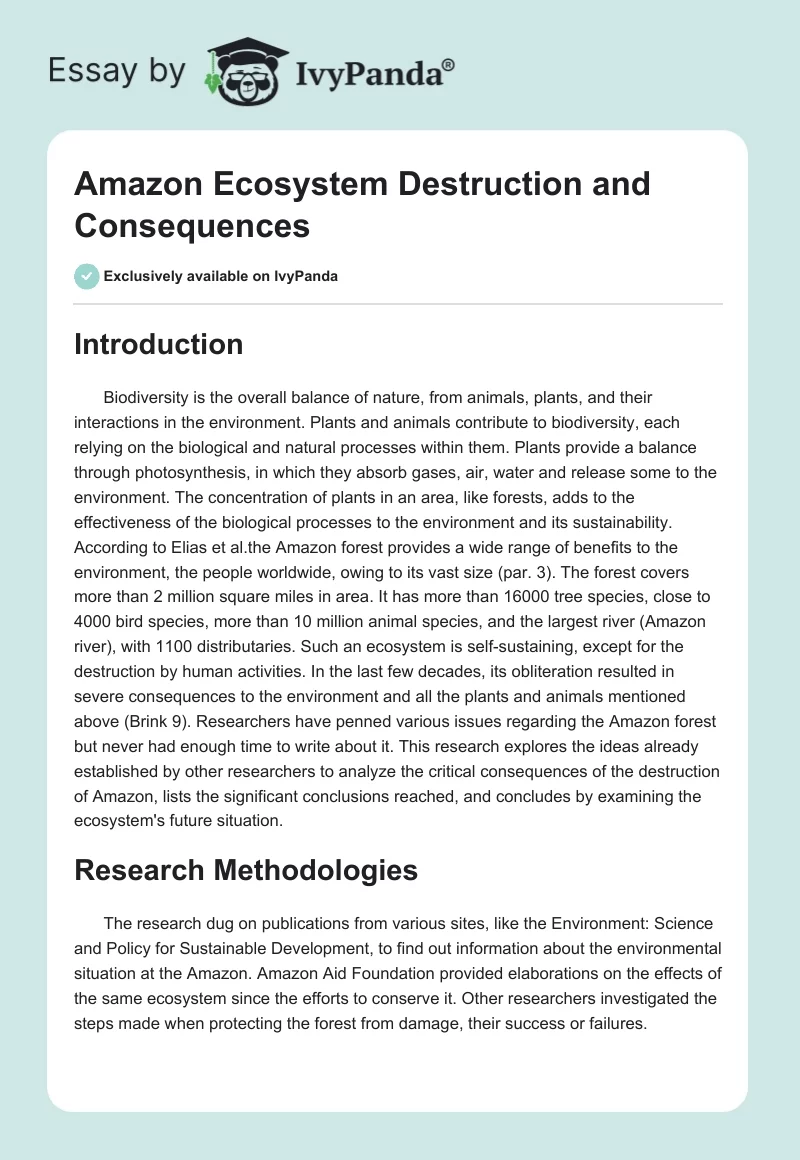Introduction
Biodiversity is the overall balance of nature, from animals, plants, and their interactions in the environment. Plants and animals contribute to biodiversity, each relying on the biological and natural processes within them. Plants provide a balance through photosynthesis, in which they absorb gases, air, water and release some to the environment. The concentration of plants in an area, like forests, adds to the effectiveness of the biological processes to the environment and its sustainability. According to Elias et al.the Amazon forest provides a wide range of benefits to the environment, the people worldwide, owing to its vast size (par. 3). The forest covers more than 2 million square miles in area. It has more than 16000 tree species, close to 4000 bird species, more than 10 million animal species, and the largest river (Amazon river), with 1100 distributaries. Such an ecosystem is self-sustaining, except for the destruction by human activities. In the last few decades, its obliteration resulted in severe consequences to the environment and all the plants and animals mentioned above (Brink 9). Researchers have penned various issues regarding the Amazon forest but never had enough time to write about it. This research explores the ideas already established by other researchers to analyze the critical consequences of the destruction of Amazon, lists the significant conclusions reached, and concludes by examining the ecosystem’s future situation.
Research Methodologies
The research dug on publications from various sites, like the Environment: Science and Policy for Sustainable Development, to find out information about the environmental situation at the Amazon. Amazon Aid Foundation provided elaborations on the effects of the same ecosystem since the efforts to conserve it. Other researchers investigated the steps made when protecting the forest from damage, their success or failures.
The Amazon forest received government protection from human activities until 2012 when stakeholders involved in safeguarding the environment remained complacent. Public outcry was reduced when the policies established to protect the environment gathered force. As a result, more destruction cases were recorded, resulting in large hectares of land being cleared for various human activities. The activities included farming, settlement, and tree logging for sale. Walker denotes that a tipping point was reached when the control measures were no longer adequate to the forces against it (16). With this, one binding effect was the displacement of animals that lived in the forest. With reducing forest size, animals moved to other regions, concentrated within some quota of the remaining forest, and sometimes endangered some.
With the vegetation coverage reducing, the balance in environmental features was disrupted. First, plants act as a cover to absorb heat in an area. They also provide moisture to the environment that cools the regions. Amazon Aid Foundation (n.d) records the changes in the Amazonian areas due to forest reduction over the years. With the disruption in the balance of temperature, other features like rivers and snow reduced. Streams that built distributaries dried up and deprived the significant rivers of the flow to regions they provided water. High temperatures were affecting the formation of rains, the production of crops, and the survival of animals adapted to colder temperatures. According to Azenha et al. the same continued for a long and would render some rivers or animals extinct after a few years (1). Attempts to restore the forest do not yield similar conditions as before, making the return to normalcy tricky.
Results
The damage to the Amazon forest disrupted the ecosystem and endangered people living in the areas. The climate and weather patterns changed from the reduced heat, imbalanced intake and release of gases, soil erosion increased, streams dried, and rainfall patterns changed. The government established policies for some period in Brazil but never bore enough fruits when the people grew complacent. Forces employed in damaging the environment outmatched the ones controlling safeguarding it.
Discussion
The environment is facing many human activities that threaten to damage its existence. Animals and plants provide for a balance of biological processes. The effects are beyond what humans can handle, nor the environment itself. With the adverse effects of climate change, the destruction of the Amazon presents a much bigger problem to address and solve (Walker 18). Laws established to safeguard the environment are not yielding the necessary effects, showing the less determination of the states concerned in keeping to their promise. Additionally, people face various challenges like unemployment, hence the reliance on the forest for farming and logging for wood sale. Finally, environmental education is lacking in most parts of the world, especially people living in forested lands and are engaging in illegal logging activities.
Conclusion
Amazon rainforest is facing severe damage from human activities, which later destroys its biosystem. Reduction of forest cover leads to pollution, drying of rivers, melting of snows, death of animals, displacements, and imbalanced temperatures. Governments never established appropriate policies to ensure a reduction of the practices leading to its destruction. Research from various organizations suggests a worsening situation that needs to be addressed.
Works Cited
Azenha, G. S., et al. Frontiers of Development in the Amazon Riches, Risks, And Resistances. Lexington Books, 2020.
Brink, T. V. Protecting the Amazon Rainforest. North Star Editions, 2020.
“Effects of Deforestation on the Amazon”. Amazon Aid Foundation, n.d, Web.
Elias, F. et al. “Assessing the Growth and Climate Sensitivity Of Secondary Forests In Highly Deforested Amazonian Landscapes”. Ecological Society of America, vol. 101, no.(3). 2019. Web.
Walker, R. T. “Collision course: Development pushes Amazonia Toward its Tipping Point”. Environment: Science and Policy for Sustainable Development, vol. 63 no. (1), 2020. 15-25. Web.

 4.00
4.00
